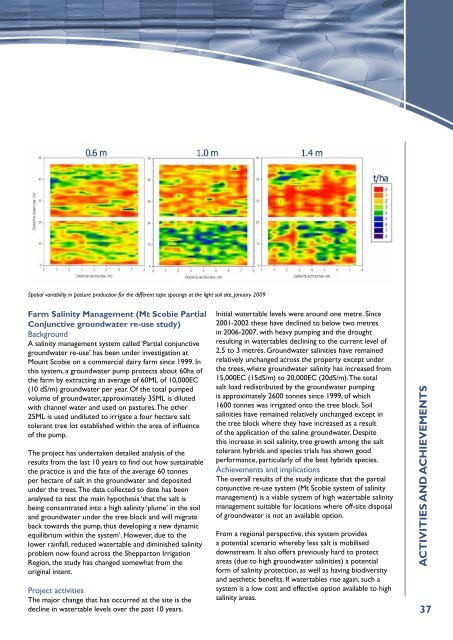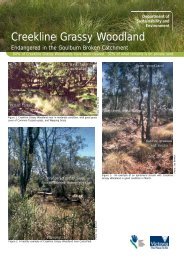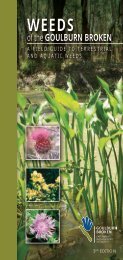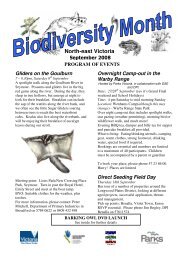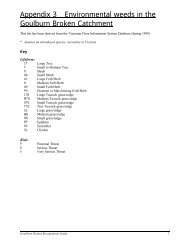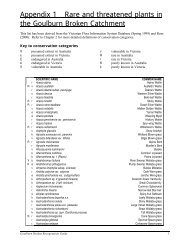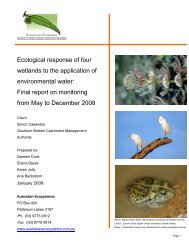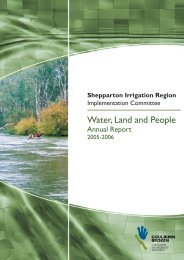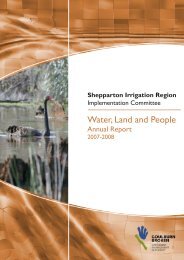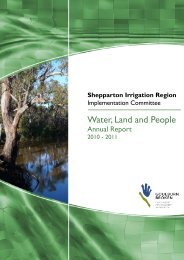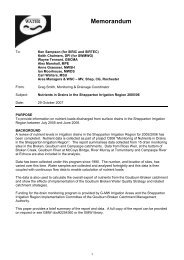Water, Land and People - Goulburn Broken Catchment ...
Water, Land and People - Goulburn Broken Catchment ...
Water, Land and People - Goulburn Broken Catchment ...
Create successful ePaper yourself
Turn your PDF publications into a flip-book with our unique Google optimized e-Paper software.
Spatial variability in pasture production for the different tape spacings at the light soil site, January 2009<br />
Farm Salinity Management (Mt Scobie Partial<br />
Conjunctive groundwater re-use study)<br />
Background<br />
A salinity management system called ‘Partial conjunctive<br />
groundwater re-use’ has been under investigation at<br />
Mount Scobie on a commercial dairy farm since 1999. In<br />
this system, a groundwater pump protects about 60ha of<br />
the farm by extracting an average of 60ML of 10,000EC<br />
(10 dS/m) groundwater per year. Of the total pumped<br />
volume of groundwater, approximately 35ML is diluted<br />
with channel water <strong>and</strong> used on pastures. The other<br />
25ML is used undiluted to irrigate a four hectare salt<br />
tolerant tree lot established within the area of influence<br />
of the pump.<br />
The project has undertaken detailed analysis of the<br />
results from the last 10 years to find out how sustainable<br />
the practice is <strong>and</strong> the fate of the average 60 tonnes<br />
per hectare of salt in the groundwater <strong>and</strong> deposited<br />
under the trees. The data collected to date has been<br />
analysed to test the main hypothesis ‘that the salt is<br />
being concentrated into a high salinity ‘plume’ in the soil<br />
<strong>and</strong> groundwater under the tree block <strong>and</strong> will migrate<br />
back towards the pump, thus developing a new dynamic<br />
equilibrium within the system’. However, due to the<br />
lower rainfall, reduced watertable <strong>and</strong> diminished salinity<br />
problem now found across the Shepparton Irrigation<br />
Region, the study has changed somewhat from the<br />
original intent.<br />
Project activities<br />
The major change that has occurred at the site is the<br />
decline in watertable levels over the past 10 years.<br />
Initial watertable levels were around one metre. Since<br />
2001-2002 these have declined to below two metres<br />
in 2006-2007, with heavy pumping <strong>and</strong> the drought<br />
resulting in watertables declining to the current level of<br />
2.5 to 3 metres. Groundwater salinities have remained<br />
relatively unchanged across the property except under<br />
the trees, where groundwater salinity has increased from<br />
15,000EC (15dS/m) to 20,000EC (20dS/m). The total<br />
salt load redistributed by the groundwater pumping<br />
is approximately 2600 tonnes since 1999, of which<br />
1600 tonnes was irrigated onto the tree block. Soil<br />
salinities have remained relatively unchanged except in<br />
the tree block where they have increased as a result<br />
of the application of the saline groundwater. Despite<br />
this increase in soil salinity, tree growth among the salt<br />
tolerant hybrids <strong>and</strong> species trials has shown good<br />
performance, particularly of the best hybrids species.<br />
Achievements <strong>and</strong> implications<br />
The overall results of the study indicate that the partial<br />
conjunctive re-use system (Mt Scobie system of salinity<br />
management) is a viable system of high watertable salinity<br />
management suitable for locations where off-site disposal<br />
of groundwater is not an available option.<br />
From a regional perspective, this system provides<br />
a potential scenario whereby less salt is mobilised<br />
downstream. It also offers previously hard to protect<br />
areas (due to high groundwater salinities) a potential<br />
form of salinity protection, as well as having biodiversity<br />
<strong>and</strong> aesthetic benefits. If watertables rise again, such a<br />
system is a low cost <strong>and</strong> effective option available to high<br />
salinity areas.<br />
ACTIVITIES AND ACHIEVEMENTS<br />
37


